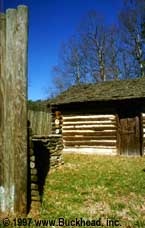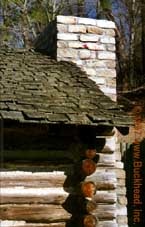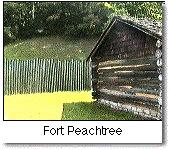





With Creek Indians as British allies & Cherokees
loyal to U.S., in War of 1812, it was expedient to
locate a fort at Standing Peach Tree on the
Chattahoochee - the boundry line. Lt. Geo. Gilmer
(later, twice Gov. of Georgia) was sent here ( 1814)
with a small force to erect a fort & protect workman
building flat boats for shipping supplies to Ft.
Mitchell. Lt. Gilmer’s fort was built on the knoll N.
of & at mouth of Peachtree Cr. J.McC. Montgomery,
Supt. of Artificers, set up the boat yard in the flat area
S. of the Cr. - a bridge connecting it with the fort.
Montgomery returned to this vicinity as a resident
about 1821
060-61 Ga. Historical Commission 1956 Location -- Ridgewood Rd. at Ridgewood Circle






Fort Peachtree, 2630 Ridgewood Road, replica of part of the first non-Indian settlement in Atlanta built by City of Atlanta Bureau of Water near the Atlanta Waterworks pumping station as part of the bicentennial celebration.
Nearby is a rustic stone picnic shelter with a beamed roof, fireplace, granite benches and access to toilets.
This low bluff overlooking the Chattahoochee River at its confluence with Peachtree Creek takes the imagination far back into Atlanta's history. A major Creek Indian settlement, Standing Peachtree lined the banks of the river here and ran up Peachtree Creek as far back as its junction with Nancy Creek. The river was the frontier between the Creek and Cherokee Indian nations and Standing Peachtree was a major contact point for both Indians and white traders.
It's the site from which Peachtree Street/Road takes its name, though some believe instead of a peach tree a commanding pine, or "pitch" tree, stood at the site and was the origin of the name.



